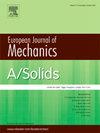Behavior of monolithic and composite shields under space debris impact
IF 4.4
2区 工程技术
Q1 MECHANICS
引用次数: 0
Abstract
Designing space structures for long-duration missions requires accounting for the impact of space debris. This involves assessing lightweight, high-strength composite shields, commonly used in aerospace applications, for their response to hypervelocity impacts. The available research on this subject mostly focuses on determining the size of space debris such as spheres, cylinders, disks, and rings which must be resisted by the shields. However, there have been fewer studies on ellipsoidal debris. Predicting the average residual velocity of space debris and determining a ballistic limit of shields are important for ensuring structural safety against space debris impact. This study investigates the ballistic performance of Al-2024-T3 aluminum alloy, nylon 66 polymer (NY66), nylon 66 fiber (NYF66), and their composite shields under hypervelocity impacts with ellipsoidal debris. The shape factor (SF), based on the length-to-diameter (L/d) ratio, categorizes the ellipsoidal debris. The Johnson-Cook model for Al-2024-T3 and the Elastic-Plastic Hydro model for NY66 and NYF66 were calibrated and the simulations performed on LS-DYNA code validated with experimental results. Modified equations for ballistic limit and residual velocity were derived from computational results. Among the materials, NYF66 showed superior ballistic resistance. Composite Type-A was optimal for hypervelocity impacts, while Type-C1 excelled in high-velocity impacts.
求助全文
约1分钟内获得全文
求助全文
来源期刊
CiteScore
7.00
自引率
7.30%
发文量
275
审稿时长
48 days
期刊介绍:
The European Journal of Mechanics endash; A/Solids continues to publish articles in English in all areas of Solid Mechanics from the physical and mathematical basis to materials engineering, technological applications and methods of modern computational mechanics, both pure and applied research.

 求助内容:
求助内容: 应助结果提醒方式:
应助结果提醒方式:


